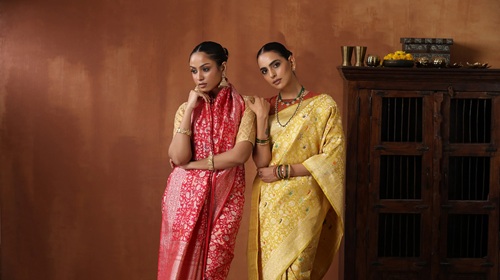The Banarasi saree is one of India’s most prestigious and traditional weaves, originating from Varanasi (Banaras), Uttar Pradesh. Known for its luxurious silk, intricate zari work, and timeless beauty, a Banarasi saree is often considered a family heirloom and a must-have for weddings and festivals. However, the market today is flooded with machine-made imitations that look similar but lack the richness, durability, and craftsmanship of an authentic Banarasi saree. As a smart buyer, it’s important to know how to identify a real Banarasi saree.

Why Banarasi Sarees are Special
- Handwoven Masterpieces: Each saree takes from 15 days to 6 months to weave, depending on the design.
- Royal Heritage: Historically worn by Mughal royalty and Indian brides.
- Unique Weaving Style: Uses pure silk and zari (gold/silver thread) with traditional motifs inspired by nature, temples, and Mughal art.
Key Ways to Identify a Real Banarasi Saree
1. Check the Weaving Technique
- Flip the saree and examine the reverse side.
- A genuine Banarasi saree will have floats of threads (loose weaves) behind the motifs, showing handloom work.
- Machine-made imitations usually have a smooth back with no thread floats.
2. Look for the GI Tag or Silk Mark
- Authentic Banarasi sarees carry a Geographical Indication (GI) tag and often a Silk Mark label issued by the Government of India.
- If missing, be cautious — it may not be genuine.
3. Examine the Zari Work
- Traditional Banarasi sarees use zari made of gold or silver-coated thread on silk.
- The shine is subtle, rich, and long-lasting.
- Fake sarees use plastic or synthetic metallic threads, which look overly shiny and fade quickly.
4. Identify Traditional Motifs
- Common motifs include:
- Kalga and Bel (floral patterns)
- Paisley designs
- Jhallar (a series of leaves at the edge)
- Butidar motifs (small designs throughout)
- Authentic sarees have intricate and delicate patterns, not printed or roughly woven ones.
5. Texture and Weight
- Real Banarasi sarees are made from pure silk and tend to be heavier due to the zari work.
- Fake ones made of polyester or mixed fabric feel lightweight and stiff.
6. Pallu and Border Detailing
- The pallu (end piece) of a real Banarasi saree is grand and richly decorated.
- The border usually has continuous, detailed weaving, unlike printed or machine embroidery on duplicates.
7. Burn Test for Fabric (with caution)
- If you can test a small thread, burn it carefully.
- Pure silk smells like burnt hair and leaves a black ash.
- Synthetic fabric smells like burnt plastic and leaves a hard bead.
Common Types of Banarasi Sarees
- Katan Banarasi: Pure silk with elaborate designs.
- Organza (Kora) with Zari: Lightweight with zari motifs.
- Georgette Banarasi: Fine fabric with delicate embroidery.
- Shattir: Known for exclusive, creative patterns.
Tips for Buyers
- Always buy from reputed shops or certified handloom stores.
- Don’t fall for extremely low prices — authentic Banarasi sarees are expensive due to the craftsmanship.
- Ask the seller about weaving time, silk mark certification, and zari type.
Final Thoughts
A Banarasi saree is not just clothing but a legacy passed down through generations. To ensure you own a genuine piece of Indian heritage, pay attention to the weaving details, zari quality, motifs, and certification. While machine-made sarees may look similar, the richness, craftsmanship, and grace of a real Banarasi saree are unmatched. When you wear an authentic Banarasi, you carry a piece of Varanasi’s cultural heritage with pride.